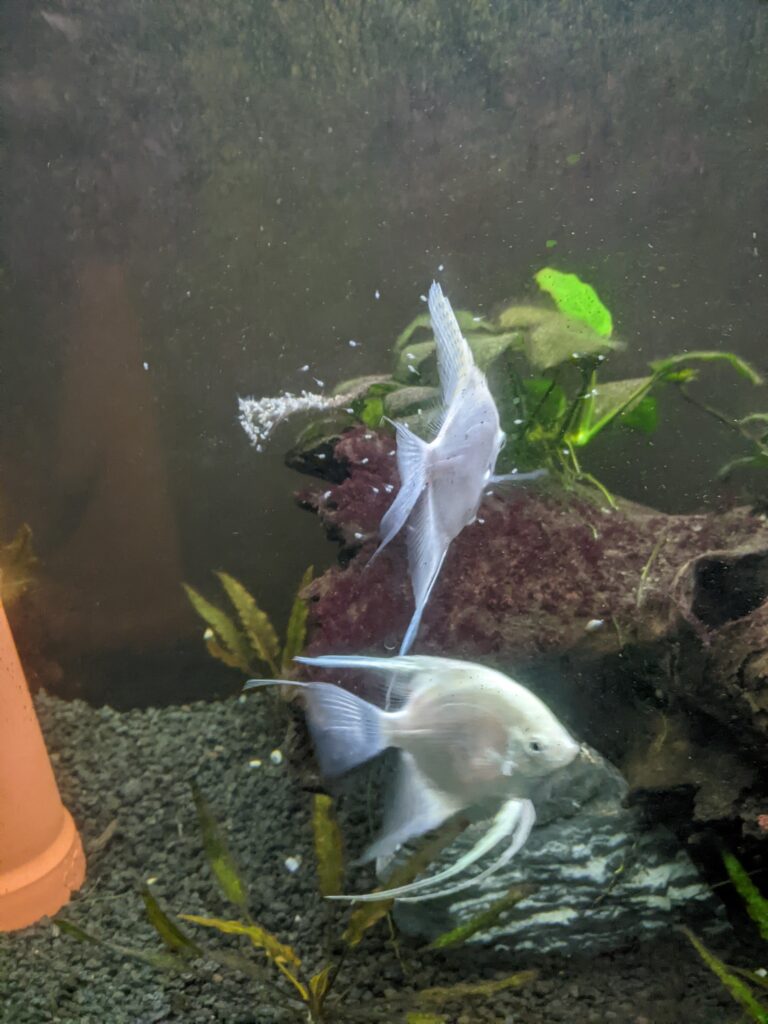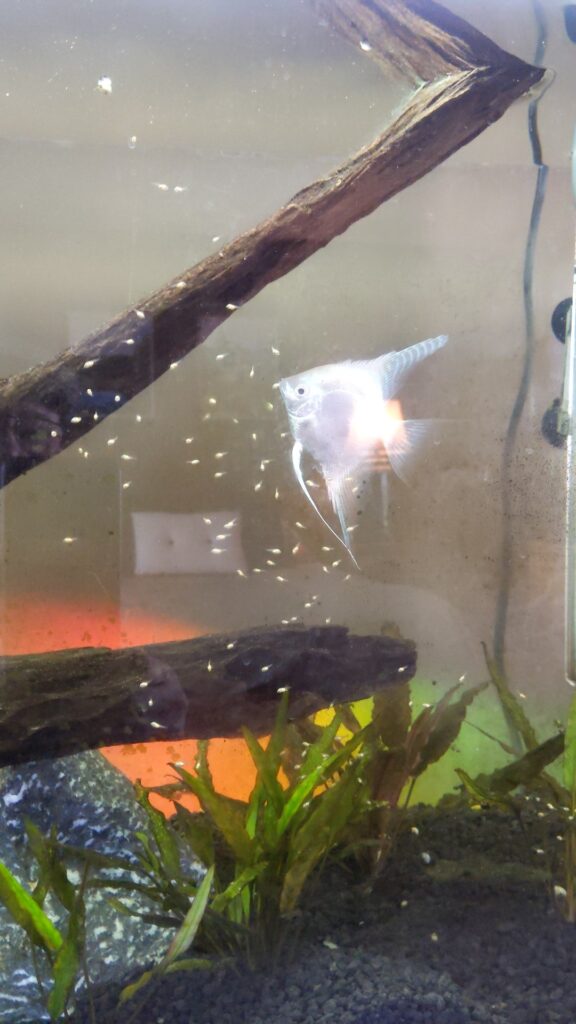
Bringing Nature Inside – Breeding Angelfish
by Bill Colombo and Dave Gadbow

The Gadbow family is pretty large and one of the ways we stay in touch is with family group texts. In January and February of this year, we all got to witness a really interesting project done by our brother-in-law, Bill Colombo. Here is the text chain with videos that we shared as Dave sent us updates on Bill’s progress. In this post, “Bill” is Bill Colombo, and the other Bill is “Bill G”.
video of eggs — mom spits one back into the pile at end
January 11 – Dave: Bill has wigglers. The eggs were fertilized on the cone and later moved to this leaf. They hatched two days ago. He is so excited.
January 11 – Celeste: That’s great.
January 11 – Jim: Thumbs up emoji.
video of Bill’s wigglers
January 15 – Dave: Bill’s Angelfish laid fertilized eggs that have hatched!
January 15 – Celeste: Wow wow wow!
January 15 – Michele: That’s awesome. Colombo Fish Hatchery! Open for business.
January 15 – Jim: That’s so cool.
January 15 – Bill G: Very nice. The tank must be perfect to get this result. Thanks for sharing.
January 15 – Dave: Bill has been watching the parents suck up the runaway babies and spit them back into the group.
January 15 – Celeste: Liked the previous post.
January 15 – Dave: There may be 200 or more.
January 15 – Bill G: Since it is a school of fish, Celeste, Michele, Jim, Sue, and Nancy (who are all teachers) should be able to help out.
video of tiny angels
February 4 – Dave: Bill has about 100 fish that survived. They have fins now.
February 4 – Celeste: Wow.
February 4 – Mary: What’s he going to do with them?
February 4 – Dave: He will sell them back to the Reef Shop. Local bred fish demand a higher price. They will give him $5 per fish and sell them at $50 each.
February 4 – Dave: In three to four weeks, they’ll be too big for the tank.
February 4 – Dave: In just a few days, they’ve turned from fuzzy stars into tiny angels! Bill has a second pair that is laying eggs, but they keep eating them.
February 4 – Mary: Are there any other fish in the tank that may be a danger to the little ones? Is that why the parents are keeping them clustered on one side of the tank.
February 4 – Dave: Also in the tank are 3 tetras, four Corey’s, and one Plecostomus that stays hidden, and a bunch of snails.
February 4 – Bill G: You guys have done great raising baby fish. One technique that Mike used when adults were eating the babies or eggs was to move the adults to a different tank at least temporarily, until the new fish got big enough to escape the larger fish.
February 4 – Dave: Bill is trying to get the adult parents to raise the fish. He’s had three pairs laying eggs but has only been successful with this one pair at getting to this stage. The guys at the store are impressed that he has done this as they’ve only had success with the breeding tank approach.
February 4 – Dave: Bill has watched the parents suck up several of the fry to relocate them. Now that they are bigger, the parents blow them around. Mom seems to have a method where she raises and lowers her fins to call them to her.
February 4 – Michele: I feel like we have front row seats to a science experiment! Thanks for providing the narrative, Dave! And thanks to Bill for providing the show!
February 4 – Sue: So cool! – followed by fish emojis.
February 4 – Michele: Your series of videos is a great visual fish development crash course. Add a narrative and you could market it – or at least have a YouTube series!
EDITOR’s NOTE: It would also make an excellent article for a Nature website!!!
video of much bigger angels
February 13 – Dave: The kids grow up so fast these days. Bill wanted to share this with you.
February 13 – Mary: That is truly amazing.
February 13 – Celeste: It truly is.
February 13 – Dave: Mom would have enjoyed the attentive parenting. You wouldn’t expect it from fish. But Dad would have just been enthralled, like Bill, with all the interaction. There’s a few that are really so tiny and at least two weeks behind the others. They hover near the bottom of the tank and Bill takes extra care to make sure they get fed.
February 13 – Dave: The Angelfish pair in the basement once again laid eggs and then ate them two days later. Bill is still hoping they’ll get there.
February 13 – Michele: So wonderful to experience along with you two. Thanks!
February 13 – Jim: Wow so many little ones! Are they called “fry” at this stage?
February 13 – Dave: We think this is the end of the fry stage. They’re still tiny but now completely resemble an Angelfish. They bump into the parents and nibble on their fins. They’re too large for the parents to blow around now. Somehow, they keep them in line. Bill said at night they all line up facing the same direction when he dims the lights. And when the lights are out, they just float to the bottom in formation with Mom and Dad floating above them.
February 13 – Jim: How cool!
video of angels on March 1, 2022
UPDATE and links:
Here is a link that Dave provided for those wanting to get more deeply into the science:
https://youtube.com/c/TheDave333
This site has lots of info on fish care and breeding and fish in nature. It has a great video on Angelfish breeding that Bill and Dave watched before starting the project. Bill followed almost all of the advice, including reducing the water level and pump flow to allow the fry to get to the air bubbles. Bill couldn’t find the recommended white worms, so instead he bred brine shrimp under two light bulbs and a bubbler.
As of March 8, the fish are getting large enough to start moving them to another tank. So far Bill has moved ten of the larger babies and is observing them to make sure they adapt to the new tank. The female adult is showing signs of being ready to lay eggs again, but Bill expects that she is holding off because the baby fish might eat the new eggs. He expects that as soon as this generation gets moved, the next generation will start.
On March 11, a second pair of calico Angelfish in a different tank hatched out fifty new babies.
SOME STILL SHOTS, in chronological order:





